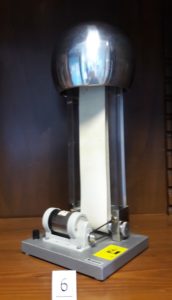
IT – È un generatore elettrostatico, ideato intorno al 1930 dall’ingegnere americano Robert Jemison Van de Graaff, che permette di accumulare un’elevata quantità di carica elettrostatica. Una colonna di materiale isolante sostiene una grande sfera metallica cava; nella colonna scorre una cinghia flessibile di gomma, tesa tra due pulegge e mantenuta in rotazione da un motore. La cinghia in movimento, elettrizzata per strofinio, permette di caricare la superficie esterna della sfera conduttrice. La carica elettrostatica accumulata genera un campo elettrico che va a ionizzare l’aria circostante, producendo scariche verso altri conduttori presenti in prossimità. La differenza di potenziale tra la sfera e il suolo può raggiungere 100 kV: dato che la quantità di cariche implicate nel processo è piccola, non vi è alcun rischio per la persona.
GB – Van de Graaff generator – It is an electrostatic generator, conceived around 1930 by the American engineer Robert Jemison Van de Graaff, which permits the accumulation of a high quantity of electrostatic charge. A column of insulating material supports a large hollow metal sphere; a flexible rubber belt runs in the column, stretched between two pulleys and kept in rotation by a motor. The moving belt, electrified by rubbing, allows it to load the external surface of the conductive sphere. The accumulated electrostatic charge generates an electric field that ionizes the surrounding air, producing discharges towards other conductors in proximity. The potential difference between the sphere and the ground can reach 100 kV but since the quantity of charges involved in the process is small, there is no risk for the person operating the generator.